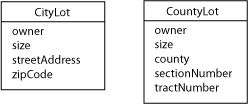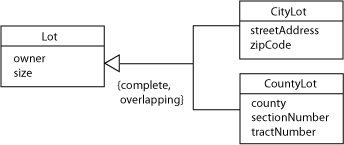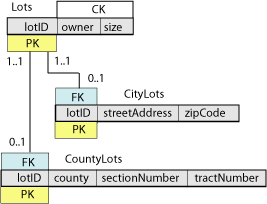Design pattern: subclasses
Top down design
As you are developing a class diagram, you might discover that one or more attributes of a class are characteristics of only some individuals of that class, but not of others. This probably indicates that you need to develop a subclass of the basic class type. We call the process of designing subclasses from “top down” specialization; a class that represents a subset of another class type can also be called a specialization of its parent class.
Example: we will model the graduate students at a university. Some are employed by the university as teaching associates (TAs); some are employed as research associates (RAs); some are not employed by the university at all. For the TAs, we need to know which course they are assigned to teach; for the RAs, we need to know the grant number of the research project to which they are assigned. A first listing of the student attributes might look like this:
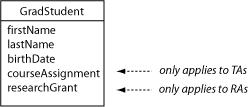

Specialization constraints
Rather than the usual cardinality/multiplicity symbols, the subclass association line is labeled with specialization constraints. Constraints are described along two dimensions: incomplete versus complete, and disjoint versus overlapping.
Relation scheme diagram
We create a table for each of the subclasses, linked to the parent class with a pk-fk pair as always. Since the relationships are one-to-one, only the fk is needed to form the pk of the subclass table. There is no way to enforce the specialization constraints in the table structure—this has to be done by the data entry system. Notice that there is no attribute in the parent table to tell us if a student is a TA, an RA, or neither—the union of two outer join queries will produce a table with all of the information that we need.
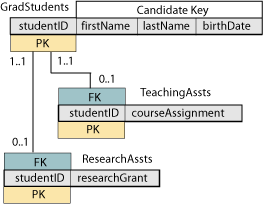
Bottom up design
Sometimes, instead of finding unique attributes in a single class type, you might find two or more classes that have many of the same attributes. This probably indicates that you need to develop a superclass of the classes with common attributes. We call the process of designing subclasses from “bottom up” generalization; a class or entity that represents a superset of other class types can also be called a generalization of the child types. Note: if you have two or more class types with exactly the same set of attributes, you probably have only one class type instead of many!
Example (thanks to Martin Malolepszy): A student of mine had a summer job with a brush-clearing service. This is a fairly specialized business but an essential one in southern California, where dried plant growth (brush) can present a severe fire hazard if it is not cleared from around houses and other structures. In addition to his exhausting physical work, Martin built a small database to help the owner manage this business.
